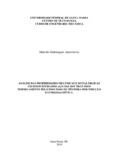| dc.contributor.advisor | Limberger, Inácio da Fontoura | |
| dc.creator | Antochefes, Marcelo Dalenogare | |
| dc.date.accessioned | 2020-01-06T13:59:36Z | |
| dc.date.available | 2020-01-06T13:59:36Z | |
| dc.date.issued | 2019-12-09 | |
| dc.date.submitted | 2019-12-09 | |
| dc.identifier.uri | http://repositorio.ufsm.br/handle/1/19281 | |
| dc.description.abstract | This paper presents a study on the adaptation of an electromagnetic induction quenching machine, which is used to temper thin helical plates to be used in the tempering of splined shaft tips, used in the junction between the engine and the axis of the helical components that make up the chupim that transports grain into the bulk silos produced by COFELMA Metallurgical Industry. The purpose of the paper is to be able to evaluate the metallurgical and mechanical properties of splined shafts, machined in SAE 1045 steel. After the induction hardening process on the splined axes, these were submitted to surface hardness tests longitudinally on the stretch marks, radial hardness in two cross sections and metallographic analysis of cross sections. After performing the surface hardness tests longitudinally and evaluating the values obtained and their distribution along the length, it was clear that the set of coils used did not provide an efficient tempering. Only one half of an axis had surface quenching, which was confirmed by the radial hardness values in the cross section and the presence of martensite in the observations of the metallographs made in these sections. Thus it can be seen that the modifications made to the equipment were not effective and significant changes should be made to the suitability of the process. Therefore, changes are recommended, such as: increase the flow of cooling fluid, the axes should be vertical, the speed of rotation should be higher and a two-turn coil should be used and should travel from the bottom up with the cooling system running right behind the coil. | eng |
| dc.language | por | por |
| dc.publisher | Universidade Federal de Santa Maria | por |
| dc.rights | Acesso Aberto | por |
| dc.subject | Têmpera por indução eletromagnética | por |
| dc.subject | Eixos estriados | por |
| dc.subject | Dureza | por |
| dc.subject | Aço SAE 1045 | por |
| dc.subject | Eletromagnetic induction quenching | eng |
| dc.subject | Splined shafts | eng |
| dc.subject | Hardness | eng |
| dc.subject | SAE 1045 steel | eng |
| dc.title | Análise das propriedades mecânicas e metalúrgicas em eixos estriados aço SAE 1045 tratados termicamente pelo processo de têmpera por indução eletromagnética | por |
| dc.title.alternative | Evaluation of induction quenching process parameters and mechanical e metallurgical properties on slpine shafts | eng |
| dc.type | Trabalho de Conclusão de Curso de Graduação | por |
| dc.degree.local | Santa Maria, RS, Brasil | por |
| dc.degree.graduation | Engenharia Mecânica | por |
| dc.description.resumo | Este trabalho apresenta um estudo sobre a adaptação de uma máquina de têmpera por indução eletromagnética, que é usada para temperar chapas finas helicoidais para ser usada na têmpera de ponteira de eixos estriado, utilizados na junção entre o motor e o eixo dos helicoides que compõem o chupim que transporta grãos para o interior dos silos graneleiros produzidos pela Metalúrgica COFELMA. O objetivo do trabalho é avaliar as propriedades metalúrgicas e mecânicas dos eixos estriados, usinados em aço SAE 1045. Após a realização do processo de têmpera por indução nos eixos estriados, estes foram submetidos a ensaios de dureza superficial no sentido longitudinal sobre as estrias, dureza radias em duas seções transversais e análise metalográfica das seções transversais. Realizados os ensaios de dureza superficiais no sentido longitudinal e avaliado os valores obtidos e a sua distribuição ao longo do comprimento, ficou claro que o conjunto de bobinas usados não propiciou uma têmpera eficiente. Apenas uma metade de um eixo teve têmpera superficial, que foi comprovada pelos valores de dureza radial na seção transversal e pela constatação da presença de martensita nas observações das metalografias feitas nestas seções. Desta forma pode-se constatar que as modificações feitas no equipamento não foram eficazes e devem ser feitas mudanças significativas para a adequação do processo. Para tanto são recomendadas mudanças tais como: aumentar o fluxo de fluido refrigerante, os eixos devem ficar na vertical, a velocidade de rotação deve ser maior e deve ser usado uma bobina com duas voltas e deve se deslocar de baixo para cima com o sistema de resfriamento ligado seguindo logo atrás da bobina. | por |
| dc.publisher.country | Brasil | por |
| dc.publisher.initials | UFSM | por |
| dc.subject.cnpq | CNPQ::ENGENHARIAS::ENGENHARIA MECANICA | por |
| dc.publisher.unidade | Centro de Tecnologia | por |


